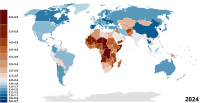
Photo from wikipedia
Little is known about whether and how trends in completed cohort fertility and lifetime childlessness by education have changed over time. This study uses census data to describe the changes… Click to show full abstract
Little is known about whether and how trends in completed cohort fertility and lifetime childlessness by education have changed over time. This study uses census data to describe the changes in completed family size and proportions ultimately childless by educational attainment of Australian women born between 1952–1971 (N = 2,518,571). In all cohorts, better-educated women have lower fertility levels than their lesser-educated counterparts. The decline in completed fertility has, however, slowed among recent cohorts of women with university degrees, while it has been declining at a faster pace among women with Year 12 and Diploma qualifications. The positive effect of education on childlessness has also reduced. The gap in ultimate childlessness between women with university degrees and women with Year 12 qualifications or below has been markedly narrowing across the cohorts under observation, while the increasing trend in childlessness has recently reversed among women with university degrees. There was an overall difference of 12 percentage points between the proportion of higher educated women childless across fields of study, with the highest values occurring for women educated in the arts, agriculture, information technology and social sciences and the lowest values occurring for women educated in health and education. Despite such differences, women educated in all fields of study, apart from engineering, contributed to the recent decline in the proportion childless. The relationship between motherhood and marriage has remained stronger among better-educated women, while it weakened for lesser-educated groups.
Journal Title: Journal of Population Research
Year Published: 2021
Link to full text (if available)
Share on Social Media: Sign Up to like & get
recommendations!